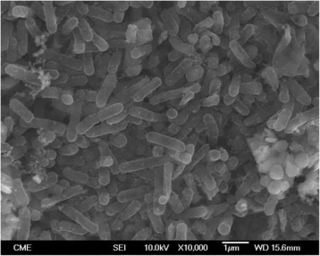Current Biomining Methods
Biooxidation (Biological pre-treatment)
Biological pre-treatment utilizes the natural oxidation abilities of microorganisms to remove unwanted minerals that interfere with the extraction of the target metals. [16] This is not always necessary but is widely used in the removal of arsenopyrite and pyrite from gold (Au). [16] Adidithiobacillus spp. release the gold by the following reaction. [17]
- 2 FeAsS[Au] + 7 O2 + 2 H2O + H2SO4 → Fe2(SO4)3 + 2 H3AsO4 + [Au]
Stirred tank bioreactors are used for the biooxidation of gold. [16] While stirred tanks have been used to bioleach cobalt for copper mine tailings, [18] these are costly systems that can reach sizes of >1300m3 meaning that they are almost exclusively used for very high value minerals like gold. [16]

Bioleaching (Bioprocessing)
Dump Bioleaching
Dump Bioleaching was one of the first widely used applications of biomining. In dump bioleaching, waste rock is piled into mounds (>100m tall) and saturated with sulfuric acid to encourage mineral oxidation from native bacteria. [16] Inoculation of the rock with bacteria is often not preformed in dump bioleaching which instead relies on the bacteria already present in the rock. [16]
Heap Bioleaching
Heap bioleaching is a newer take on dump leaching. [16] The process includes more processing in which the rocks are ground into a finer grain size. [16] This finer grain is then stacked only 2 – 10 m high and is well irrigates allowing for plenty of oxygen and carbon dioxide to reach the bacteria. [16] The mounds are also often inoculated with bacteria. [16] The liquid coming out at the bottom of the pile, called leachate, is rich in the processed mineral. The heaps reside on large non-porous platforms which are used to catch the leachate for processing. [16] Once collected the leachate is transported to a precipitation plant where the metal is reprecipitated and purified. The waste liquid, now void of the valuable minerals, can be pumped back to the top of the pile and the cycle is repeated. [16]
The temperature inside the leach dump often rises spontaneously as a result of microbial activities. [16] Thus, thermophilic iron-oxidizing chemolithotrophs such as thermophilic Acidithiobacillus species and Leptospirillum and at even higher temperatures the thermoacidophilic archaeon Sulfolobus (Metallosphaera sedula) may become important in the leaching process above 40 °C. [16]

In situ Biomining
In situ biomining involves the flooding and inoculation of fractured ore bodies that have yet to be removed from the ground. [16] Once the bacteria are introduced to the ore deposits, they begin leaching the precious metals, which can then be extracted as leachate with a recovery well. [19] In-situ mining also shows promise for applications in cost-effective deep subsurface extraction of metals. [20]
In situ Biomining, is the one current method utilizing bioleaching that serves as an effective and viable replacement for traditional mining. [21] Because in-situ biomining, negates the need for the extraction of the ore bodies, this method stops the need for any hauling or smelting of the ore. [20] This would mean there would be no waste rocks or mineral tailings that contaminate the surface. [20] However, in-situ biomining also has the most environmental concerns of all of the leaching methods, as there is the potential for the contamination of ground water. [20] [21] These concerns however can be careful managed, especially because most of this mining would occur below the water table. [20]
This method was used in Canada in the 1970s to extract additional uranium out of exploited mines. [22] Similarly to copper, Acidithiobacillus ferrooxidans can oxidize U4+ to U6+ with O2 as electron acceptor. However, it is likely that the uranium leaching process depends more on the chemical oxidation of uranium by Fe3+, with At. ferrooxidans contributing mainly through the reoxidation of Fe2+ to Fe3+.
- UO2 + Fe(SO4)3 → UO2SO4 + 2 FeSO4
Applications

One of the largest applications of these leaching methods is in the mining of copper Acidithiobacillus ferrooxidans has the ability to solubilize copper by oxidizing the reduced form of iron (Fe2+) with sulfur electrons and carbon dioxide. [23] This process results in ferric ions (Fe3+) and H+ in a series of cyclical reactions.
CuFeS2+4H++O2 --> Cu2++Fe2++2S0+2H2O,
4Fe2++4H++O2 4Fe3++2H2O,
2S0+3O2+2H2O→2SO2−4+4H+,
CuFeS2+4Fe3+→Cu2++2S0+5Fe2+,
The copper metal is then recovered by using scrap iron:
- Fe0 + Cu2+ → Cu0 + Fe2+
Using Bacteria such as A. ferrooxidans to leach copper from mine tailings has improved recovery rates and reduced operating costs. Moreover, it permits extraction from low grade ores – an important consideration in the face of the depletion of high grade ores. [3]
Economic Feasibility and Potential Drawbacks
It has been well established that bioleaching allows of the cheaper processing of low-grade ore when the bacteria are given the correct growth conditions. [24] This allow for economic extraction of low-grade ore and increases mining reserves in a sustainable way. [24]
Like any process of mineral recovery there are concerns about the ability to scale biomining to the size the industry would need. The biggest potential drawbacks of biomining are the relatively slow leaching and extraction times and need for expensive specialized equipment. [14] Biomining techniques only show economic viability as a complementary process to mining, not as a replacement. Biomining may make traditional mining more environmentally and economically friendly, by re-processing fresh or abandoned mine tailings and the detoxification of copper production concentrates to generate economically valuable copper-enriched liquors. [24] There is great economic feasibility for in-situ biomining to replace traditional mining in a cheaper and more environmentally friendly way, however it has yet to be adopted on any large scale. [14]













